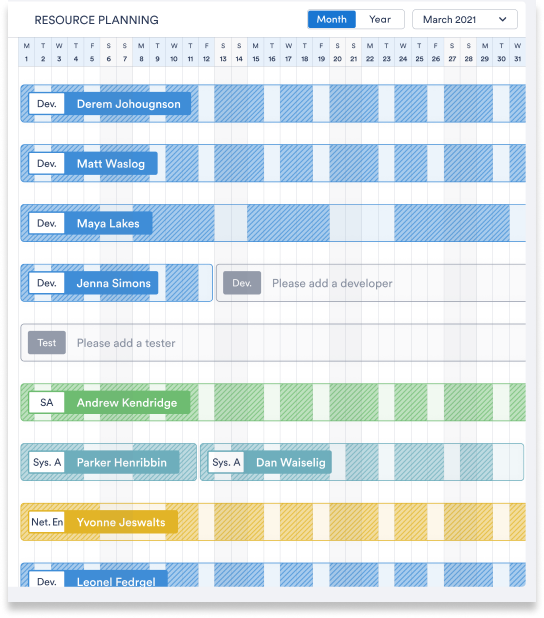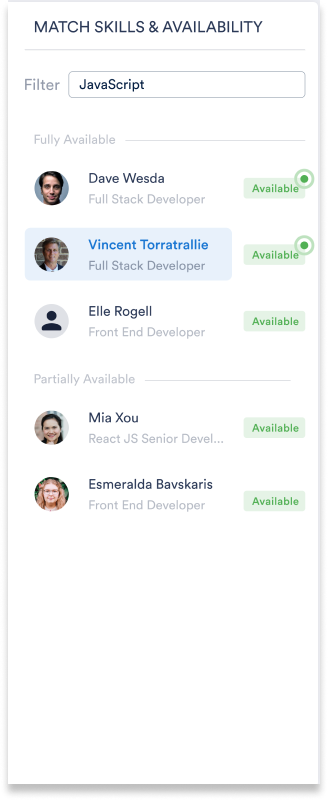Human resource capacity planning enables you to assess your current resource allocation and forecast future demand and capacity. Its main goal is to plan effectively for upcoming projects based on a data-driven approach and make sure your team always delivers. Think of resource capacity planning as a roadmap to success.
This guide will help you understand resource capacity planning and its benefits. We will equip you with a step-by-step process outline and show you why using a cloud-based resource planning tool can make your project management much more effective.

What is human resource capacity planning?
Human resource capacity planning forecasts the differences between resource capacity and resource demand. Resource capacity planning considers your company’s entire project portfolio (current, planned future, and potential future). It gathers and analyzes all available information about resources, including current resource allocation, already allocated future resources, resource skills sets, project skills demands, future project demand, and any gaps. It gives you an informed and flexible approach to planning and delivering projects.
Benefits of resource capacity planning
“What’s in it for me, my project, my team, and the company?”
When you identify the capacity/demand gap, you are better able to forecast projects. There are three main interrelated benefits of resource capacity planning done right:
- The resource capacity information and analysis helps you make the most informed real-time decisions.
- This comprehensive approach lets you identify potential issues long before they occur. This prevents problems and minimizes risk when fulfilling your project objectives.
- Resource capacity planning lowers costs and makes it easier to stay on budget, on target, and deliver.

Here are some specific examples of these interrelated benefits:
- Avoiding resource double-booking.
- Limiting the underuse of resources.
- Predicting when resources become free and can be used for other projects.
- Making sure all resources are allocated.
- Increasing utilization rate – using the info from the four points about to maximize each resource to full capacity, or as close as possible.
- Maintaining up-to-date skills profiles of all your resources.
- Creating a company-wide skills profile.
- Informing out rotation and backfill when new project opportunities emerge.
- Prioritizing billable work – Resources do the work that pays.
- Prioritizing strategic work – Resources do the work that supports the company’s strategic decisions.
- Knowing well in advance if any skills are missing so you can make the right decisions early enough to avoid costly delays. Identifying skills gaps helps with:\- Resource allocation adjustments – When you move a resource with the right skills within a project or even transfer from another project.
- Training – If any resources have bench time they can be trained to fill a skills gap. (If there is enough time before needing to use that skill. And, if you have the training resources to accomplish this.)
- New hires – If resource allocation adjustments and/or training cannot fill the skills gaps then look to hire new talent with the right skills.
- Project feasibility – If you can’t meet the three criteria above then it might not be possible for you to take on the project; or, minimally delaying the project to do so. (Of course you want all the business you can get, but don’t forget about maintaining your reputation, based on delivering quality and meeting deadlines.)
- Making more effective sales because the sales team has a better idea of what can and can’t be offered. More projects = more revenue. This, of course, assumes your company has effective interdepartmental communications.
The human resource capacity planning process: step-by-step
“How should I plan human resource capacity?”
Find the core steps of a resource capacity planning model below. Keep in mind that you can make your own variations on this process. Your company’s culture, industry, and the type of project you’re managing will influence your decisions.
Determine Capacity
- Identify all resources, including full-time, part-time, freelance, and any other.
- Don’t forget resources that have already agreed to join at a later time.
- Highlight work schedule differences, ie normal working time expectations, known holidays, non-work days, etc. Consider different time zones during resource scheduling.
- Work out company-wide and resource-specific capacity using a common measuring unit. We recommend using 1 hour as the basic unit. We also recommend analyzing these hours in terms of weeks.
- Determine or compile the cost of each resource.
- Do a skills inventory for each resource. Don’t just list their skills generically. Rate the skills, eg, expert, strong, satisfactory, developing but limited.
- Communicate! Who are the people you need to get information from? Who needs to know about the data you are compiling and analyzing? Ideally, resource capacity planning is not done in isolation, but involves some sort of team effort.
Establish Project Portfolio
1. LIST PROJECTS. Make a list of all agreed and potential projects, current and future. Future projects should include confirmed projects and also ones that you might have a chance to take on, known as opportunities.
2. ESTIMATE TIME. Estimate billable vs non-billable hours for all the projects.
3. STRATEGIZE. Determine which are the most strategic projects. This might be based strictly on income. But, strategic projects can also be about developing the relationship with a customer and building for the future.
4. PRIORITIZE. Prioritize your projects. Some projects will take priority because they are the most billable while others might be the most strategic.
Learn more about How does resource scheduling tie to project priority.
Forecast Resource Demand & Compare to Capacity
1. SKILLS FOR EACH PROJECT. Establish which skills, and thus which resources, each project needs. Take into account preferences that your resources express, but the key and priority is skills-matching.
2. PREDICT THE FUTURE. Remember, here you are also looking at future projects’ demands, not just ones that are on-going or about to start. It may be challenging to identify all the demands, especially with opportunities, because sometimes we just don’t know until a project is underway. But, attempt to identify as many as possible at this stage.
3. SKILLS MATCHING. Skills matching is when you analyze skills needed vs. skills available. This determines which areas of each project:
a. can be covered with currently available resource capacity
b. capacity that you know will become available as tasks or projects wind down
c. have a skills gap (both excess of skills and shortage of skills).

4. START WITH THE HIGHEST PRIORITY. For steps 1 to 3, we recommend starting with the highest priority projects. This way, if time is really pressing, those projects’ demands will be clear as soon as possible. You can act on the top priorities while working out what’s needed with the lower priorities.
5. CHECK DATA, LOOK FOR TRENDS. Triple-check all your data. Make sure you are looking across the whole project’s pipeline and not overly focused on selected projects. Also, the data can be used to look at overall customer demand trends and industry trends, which can have an impact on your medium and long-term staffing. For example: Do you notice a skill that is less necessary in possible future projects? Or, do you see a skill that is being asked for more and more? How do the trends compare your available resources?
Resource allocation & maintenance
1. ALLOCATE RESOURCES. Put the right resources into the right role in the right project based on skills matching, preferences, location, and availability. At the same time, avoid over-allocation of resources.
2. USE YOUR DATA. Exploit what you know. Focus on current and future capacity, current allocation, skills sets, and work schedule differences identified earlier. Also, don’t forget their track records, e.g. to check if resources work well together.
3. USE PLACEHOLDERS IN GAPS. Where there are gaps between resource demand and availability put in placeholders so you know you need to fill those gaps. Don’t underestimate these placeholders. They are crucial as it can be easy to forget about a missing resource when you’re juggling multiple projects. Make sure they are highlighted in a clear and visual way.
4. PROCESSES TO FILL GAPS. Ensure the correct processes are in place to fill those gaps you’ve identified (eg, recruitment, resource leveling, or resource smoothing).
Learn more on the topic in Resource Leveling vs. Resource Smoothing article.
5. TIMELINE. Make sure all the projects, resource allocation, placeholders, and gap-filling processes are all on the same timeline. This lets you see the whole picture, rather than limited project-specific information.
6. RESOURCE CALCULATION AND UTILIZATION RATES. Use a resource calculation to determine resource utilization rates – this is essential. Utilization rate refers to the rate of billable hours vs non-billable and bench hours of each resource. Here’s a simple example. Imagine Stacey works 40 hours a week. She does 36 billable hours, 2 training hours, 1 admin hour, and 1 non-allocated (bench) hour. She has a rate of 90% (36 divided by 40). That’s pretty good! But, what can you do with that bench hour? There isn’t one perfect resource calculation that works for all companies. Based on your context, you need to understand all the possible types of hours resources can perform. And, you need to determine which are ‘utilized’ hours (billable) and which are not.
7. EXPLOIT UTILIZATION RATE DATA. In addition to individual utilization rates, run a resource calculation to check each project’s overall utilization rate. Are there any big differences? Any projects that have a rate that’s lower than average? This can help evaluate profitability of projects and identify which might need some resource adjustments.
8. IMPROVE UTILIZATION RATES. Can any individual resource or project utilization rates be increased by adjusting the resource allocation? The whole point of resource capacity planning is to maximize your utilization rates. This maximizes your business success. So, the point is not only to identify utilization rates, but to act on the data that emerges in a meaningful and revenue-enhancing way.
9. MONITOR AND KEEP RECORDS. Continually monitor changes and make sure there is accurate and timely record-keeping. Projects are flexible, and each change can have knock on effects, i.e. one change rarely happens in isolation and probably creates some secondary actions. For example, you move Danielle from one project to another because of her skill set. That creates secondary effects such as (a) who replaces Danielle in the first project, and (b) how are both projects’ budgets affected. It’s very helpful to keep track of all of this as they happen. But, it’s very challenging and complicated to try to spot all the changes at a later date, so stay on top of it. Agile projects involve consistent customer contact and team working. So, these records are often useful and even necessary in conversations with customers, your team, or other members of your company. Compliance procedures may demand them. They can further be used as learning points in future and on-going resource capacity planning exercises.
Difference between capacity planning and resource planning
Sometimes people use capacity planning, resource planning, and capacity resource planning as synonyms. What they all have in common is that they help your company meet its goals by leveraging resources. But, it’s worth flagging up the slight differences.
| Capacity planning | Resource planning | Resource capacity planning |
| – Predicting the business requirements of clients or projects. | – Managing the resources you have to complete a project (or task). | – Combining capacity planning and resource planning. This integrated approach enables you to plan proactively and accurately by predicting future resource demand while still getting things done now. |
| – Focuses mainly on the future. | – Focuses mainly on now. | – Focuses on now and the future. This lets you operate in a more agile manner. |
| – Comprehensive – looks at possibilities for upcoming projects. | – Isolated – may only focus on one project. | – Comprehensive – across all your projects. |
| – Needs high level decision-making (e.g. Can we take that project? Do we need to considerably delay this project?) | – Attends to detailed decision-making (e.g. Can I move Bob over to Project X next week? Jen’s an excellent freelancer and has told me she has 10 hours free each week next month – do any projects need her?) | – A mix of high level and detailed decision-making. |
| – Sometimes called demand planning. | – Sometimes called resource allocation. |
Software for effective human resource capacity planning
Put those clumsy, time-consuming spreadsheets away! Fast-track your resource capacity planning with a cloud-based software tool, such as WeekWise. This will inject efficiency, clarity, and accuracy into your human resource capacity planning.
WeekWise enables you to look across your company’s projects (current and in the pipeline). You get a bird’s eye view of everything. This overview gives you full access to complete and up-to-date resource information you need. WeekWise provides in-time financials, allocations, allocation gaps, all your resources’ skills sets, and project demands. Take a company-wide view or toggle between projects with visually appealing dashboards. Look at resources collectively or individually. Add or replace resources wherever you need, for example, joining your company and joining a project team, or when you move them from one project to the next.
WeekWise’s real-time business information provision, flexibility, and ease-of-use give you the resource capacity planning tools to drive current and continued success.